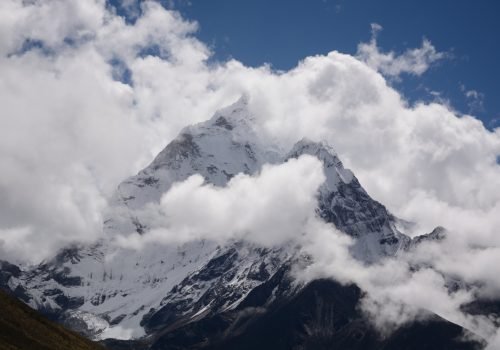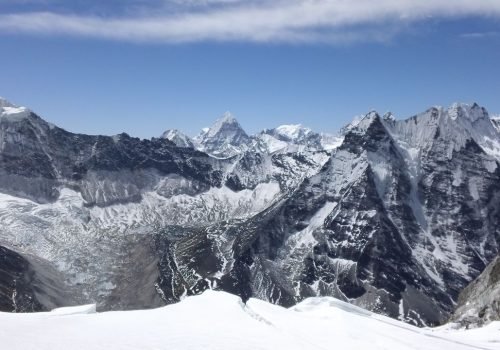-
6812M
30 Days
-
Ama Dablam Expedition
-

-
Ama Dablam is that the third most popular Himalayan peak for allowable expeditions, literally that means 'The Mother's Jewel Box'....
Annapurna Expedition - 56 Days
Trip Facts
- Duration: 56 Days
- Max Altitude: 8091m
The word ‘Annapurna’ consists of two words ‘Anna’ and ‘purna’ which means “filled with grains”. Annapurna has also got its naming roots with the goddess ‘Durga’, the Hindu Divine Mother goddess. Annapurna is that the first mountain standing within the category of the 8000m highest peaks in the world. The conversation area Project (ACAP) is protecting this area, one amongst the foremost successful conservation projects. Annapurna range stretches for 55km and creation of a series of peaks.
The world’s most dangerous mountains to climb is Annapurna. They are significantly prone to avalanches and every one of the available routes creates severe difficulties. Because the climbers have to be compelled to undergo huge ice cliffs and seracs. The western and northwestern slopes are sure by glaciers that draw off into a good gorge pass over Himalayas mountains by the Kali Gandaki river separating Dhaulagiri and Annapurna. There are four summits within the range of Annapurna.
Apart from the expedition, you’ll get to get pleasure from the attractive views of the range of mountains from the terribly renowned viewpoint- the Poon Hill. Few parts of Annapurna Conservation area, Ghorepani, and other Gurung villages: their culture, lifestyle, tradition and hospitality, floras and faunas and also the stunning Lake City- Pokhara.
Some Highlights of the Annapurna Expedition
- Summit Mount Annapurna 8091m. world tenth highest mountain.
- Stunning views of the Himalaya from the top of the Annapurna.
- Encounter the ethnic community culture.
- Visit the cultural world heritage sites of Kathmandu city.
- Adventurous hikes towards Annapurna base camp.
Best time to travel
Late Spring and autumn are the most effective seasons to plan this expedition. Because during this time the weather will be appropriate and less chance of rainfall. During this time you may have less risk of losing life due to bad weather.
Climbing Route
- Annapurna normal route is via West face and Northwest Ridge, that may be a very difficult route with Annapurna being statistically one of the most dangerous 8000m peaks. the most dangerous and tough may be a section between camp one and 2 with a really unstable and broken glacier with supporting seracs able to crash any time, being major reason for death, and eminent avalanche danger.
- The climb is completed with three camps. It takes two hrs to get from the ABC to the bottom of the climb; facing 70deg steep 500m climb with fixed ropes and danger of falling services.
- From camp 1 to Camp 2 the mounting is slightly less steep also tough with still high objective avalanche danger. This section needs also a group of regarding 1000m of fixed ropes.
- The route from Camp 2 to Camp 3 needs switchbacks navigation on the snowfield between seracs of the broken glacier. there’s still 1000m of fixed ropes needed.
- Summit try is on exposed ridge however it doesn’t need fastened ropes, it’s done as the free ascent.
Itinerary
Day 1 Arrive at Kathmandu - Transfer to your Hotel.
Day 2 Kathmandu Sightseeing (1350m).
Day 3 Preparation of the Climb.
Day 4 Drive to Beni (830m).
Day 5 Trek to Tatopani (1190m).
Day 6 Trek to Ghasa (2010m).
Day 7 Trek to Lete (2480m).
Day 8 Trek to Thulo Bugin.
Day 9 Trek to Thulo Bugin pass (4281m).
Day 10 Trek to Mrist Khola.
Day 11 Trek to Base Camp.
Day 12-47 Climbing Period.
Day 48 Cleaning up base camp.
Day 49 Trek back to Thulo Bugin.
Day 50 Trek back to Lete.
Day 51 Trek to Tukuche (2590 m) / Marpha (2627 m).
Day 52 Trek to Jomsom (2710m).
Day 53 Fly Jomsom to Pokhara (950 m) - 25 minutes, relaxing Day.
Day 54 Fly back to Kathmandu - Transfer to the Hotel.
Day 55 Farewell Day in Kathmandu (1,350m).
Day 56 Final Departure to your Destination.
Trip Includes
- All ground transport in a private vehicle including airport transfers.
- 3-star hotel accommodation in Kathmandu with breakfast.
- Kathmandu city tours, including all entry fees, tour guide and private transportation.
- Three daily meals with tea/coffee (breakfast, lunch and dinner) during the trek.
- Snacks of seasonal fruits during the trek.
- An experienced, English-speaking and government-licensed trek leader and assistant trek leader(4 trekkers: 1 assistant guide).
- Porter service (2 trekkers: 1 porter).
- Down jacket and sleeping bag (to be returned after trip completion).
- All necessary paperwork and trekking permits (ACAP, TIMS).
- First aid medicine kit.
- All government and local taxes.
Trip Excludes
- Nepalese visa fee.
- Meals not specified in the in the above itinerary.
- Personal Travel insurance.
- International airfare.
- Excess baggage charges.
- Travel and rescue insurance.
- Personal expenses (phone calls, laundry, bar bills, battery recharge, extra porters, bottle or boiled water, shower, etc).
- Tips for guide(s), porter(s) and driver(s).
The word ‘Annapurna’ consists of two words ‘Anna’ and ‘purna’ which means “filled with grains”. Annapurna has also got its naming roots with the goddess ‘Durga’, the Hindu Divine Mother goddess. Annapurna is that the first mountain standing within the category of the 8000m highest peaks in the world. The conversation area Project (ACAP) is protecting this area, one amongst the foremost successful conservation projects. Annapurna range stretches for 55km and creation of a series of peaks.
The world’s most dangerous mountains to climb is Annapurna. They are significantly prone to avalanches and every one of the available routes creates severe difficulties. Because the climbers have to be compelled to undergo huge ice cliffs and seracs. The western and northwestern slopes are sure by glaciers that draw off into a good gorge pass over Himalayas mountains by the Kali Gandaki river separating Dhaulagiri and Annapurna. There are four summits within the range of Annapurna.
Apart from the expedition, you’ll get to get pleasure from the attractive views of the range of mountains from the terribly renowned viewpoint- the Poon Hill. Few parts of Annapurna Conservation area, Ghorepani, and other Gurung villages: their culture, lifestyle, tradition and hospitality, floras and faunas and also the stunning Lake City- Pokhara.
Some Highlights of the Annapurna Expedition
- Summit Mount Annapurna 8091m. world tenth highest mountain.
- Stunning views of the Himalaya from the top of the Annapurna.
- Encounter the ethnic community culture.
- Visit the cultural world heritage sites of Kathmandu city.
- Adventurous hikes towards Annapurna base camp.
Best time to travel
Late Spring and autumn are the most effective seasons to plan this expedition. Because during this time the weather will be appropriate and less chance of rainfall. During this time you may have less risk of losing life due to bad weather.
Climbing Route
- Annapurna normal route is via West face and Northwest Ridge, that may be a very difficult route with Annapurna being statistically one of the most dangerous 8000m peaks. the most dangerous and tough may be a section between camp one and 2 with a really unstable and broken glacier with supporting seracs able to crash any time, being major reason for death, and eminent avalanche danger.
- The climb is completed with three camps. It takes two hrs to get from the ABC to the bottom of the climb; facing 70deg steep 500m climb with fixed ropes and danger of falling services.
- From camp 1 to Camp 2 the mounting is slightly less steep also tough with still high objective avalanche danger. This section needs also a group of regarding 1000m of fixed ropes.
- The route from Camp 2 to Camp 3 needs switchbacks navigation on the snowfield between seracs of the broken glacier. there’s still 1000m of fixed ropes needed.
- Summit try is on exposed ridge however it doesn’t need fastened ropes, it’s done as the free ascent.
Itinerary
Day 1 Arrive at Kathmandu - Transfer to your Hotel.
Day 2 Kathmandu Sightseeing (1350m).
Day 3 Preparation of the Climb.
Day 4 Drive to Beni (830m).
Day 5 Trek to Tatopani (1190m).
Day 6 Trek to Ghasa (2010m).
Day 7 Trek to Lete (2480m).
Day 8 Trek to Thulo Bugin.
Day 9 Trek to Thulo Bugin pass (4281m).
Day 10 Trek to Mrist Khola.
Day 11 Trek to Base Camp.
Day 12-47 Climbing Period.
Day 48 Cleaning up base camp.
Day 49 Trek back to Thulo Bugin.
Day 50 Trek back to Lete.
Day 51 Trek to Tukuche (2590 m) / Marpha (2627 m).
Day 52 Trek to Jomsom (2710m).
Day 53 Fly Jomsom to Pokhara (950 m) - 25 minutes, relaxing Day.
Day 54 Fly back to Kathmandu - Transfer to the Hotel.
Day 55 Farewell Day in Kathmandu (1,350m).
Day 56 Final Departure to your Destination.
Trip Includes
- All ground transport in a private vehicle including airport transfers.
- 3-star hotel accommodation in Kathmandu with breakfast.
- Kathmandu city tours, including all entry fees, tour guide and private transportation.
- Three daily meals with tea/coffee (breakfast, lunch and dinner) during the trek.
- Snacks of seasonal fruits during the trek.
- An experienced, English-speaking and government-licensed trek leader and assistant trek leader(4 trekkers: 1 assistant guide).
- Porter service (2 trekkers: 1 porter).
- Down jacket and sleeping bag (to be returned after trip completion).
- All necessary paperwork and trekking permits (ACAP, TIMS).
- First aid medicine kit.
- All government and local taxes.
Trip Excludes
- Nepalese visa fee.
- Meals not specified in the in the above itinerary.
- Personal Travel insurance.
- International airfare.
- Excess baggage charges.
- Travel and rescue insurance.
- Personal expenses (phone calls, laundry, bar bills, battery recharge, extra porters, bottle or boiled water, shower, etc).
- Tips for guide(s), porter(s) and driver(s).
RELATED TRIPS
-
6189M
16 Days
-
Island Peak Climbing
-

-
Island Peak climbing is great first Himalayan Peak within the region of Mount Everest. It is of altitude 6183 meter...